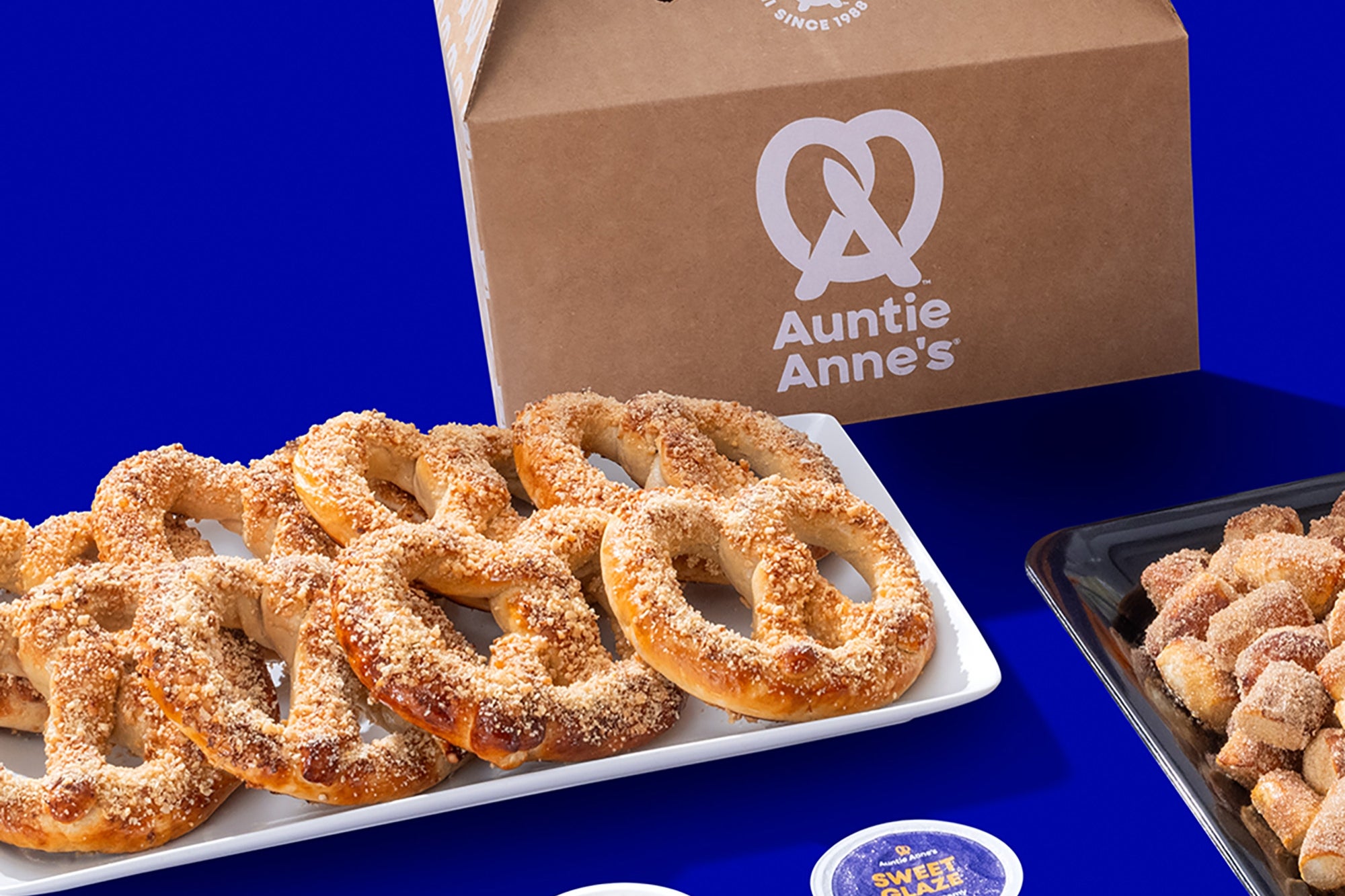Randy Labosco started as a single-unit Auntie Anne’s franchisee at a Florida mall 30 years ago. Today, the “Pretzel King of DFW” operates seven Auntie Anne’s across Dallas Fort Worth International Airport (DFW), the third-busiest airport in the world — and he’s not done yet. With plans to expand to as many as 15 total stores, including future Cinnabon and Jamba units, he’s become one of the most experienced and successful nontraditional franchise operators in the country.
“It’s walkaway food,” Labosco tells Entrepreneur. “You can pull a suitcase, carry a pretzel and not offend anyone sitting next to you on a plane. And most customers already know what they want, so we serve them in under a minute.”
That speed — along with consistency, location strategy and a deeply loyal team — has made Labosco a model franchisee for Auntie Anne’s nontraditional playbook. His journey is proof of a larger trend: Brands that master nontraditional venues like airports are finding powerful, scalable growth where others can’t.
Related: Considering franchise ownership? Get started now to find your personalized list of franchises that match your lifestyle, interests and budget.
“Built for speed”
Labosco’s success is part of a larger trend: Auntie Anne’s (#87 on the 2025 Franchise 500) outside-the-box strategy. Nontraditional franchising refers to the expansion of a franchise brand into locations outside the typical storefront model. Instead of operating in standard retail spaces like shopping centers or strip malls, nontraditional franchises are located in high-traffic, often captive environments, such as airports, travel plazas and rest stops, college campuses, stadiums and amusement parks.
These venues often offer smaller footprints, higher foot traffic and unique operational challenges (such as limited storage, security protocols or fast turnover requirements). The goal of nontraditional franchising is to meet customers where they already are — capturing impulse purchases and maximizing brand exposure in spaces that demand speed, portability and consistency.
In 2025 alone, the brand has already signed 13 new nontraditional agreements. According to parent company GoTo Foods’ chief development officer Bobby Morena, “Auntie Anne’s is built for speed — and speed is king in high-volume spaces.”
Related: Here’s how we determined the annual Franchise 500 ranking — and what we learned from the data.
Why airports work
To understand why Auntie Anne’s is thriving in airports, just picture the average traveler: hungry, rushed and looking for something fast, familiar and portable. “The brand is perfectly suited for high-throughput environments like airports, transit hubs and arenas,” Morena says, “places where customers don’t have time to browse but still want something hot and satisfying.”
Auntie Anne’s compact format and instantly recognizable products make it an ideal fit for these high-velocity settings. Most airport guests already know what they want, which helps keep lines moving. Plus, the brand’s “aroma-forward” model is a strategic advantage: Travelers often smell Auntie Anne’s before they see it, and the scent of fresh-baked pretzels pulls them in.
For franchisees like Labosco, those advantages are backed by data. His airport locations consistently outperform traditional mall stores, not just in volume but in sales per square foot. And thanks to Auntie Anne’s operational efficiency, even one point-of-sale terminal can generate millions in revenue. “Our airport stores do about 70% more in sales than traditional,” Labosco says. “We have one that’s 330 square feet with one point-of-sale, and it’s our busiest store — it did over $2.2 million last year. It’s very fast-paced and has maybe 12 feet of frontage. It’s amazing how much we can do per square foot in sales compared to much bigger locations.”
Related: How Entrepreneurs and First-Time Franchisees Can Become Effective Leaders
Operational playbook
But as Morena notes, success in an airport isn’t just about foot traffic. “Airports aren’t easy,” he says. “There are strict security protocols, limited storage and pressure to serve consistently at all hours. It takes a capable operator to thrive.” That’s where Auntie Anne’s support infrastructure — and the experience of franchisees like Labosco — becomes critical. GoTo Foods provides an airport-specific operations playbook, along with tailored support to help franchisees navigate everything from compliance and construction to staffing and scheduling.
“Our team is involved from the start,” Morena says. “We help identify the right terminal locations, handle design and permitting and even construction. Not every location inside an airport is created equal — we want our stores positioned for maximum visibility and flow.”
Franchisees also gain access to shared services across GoTo Foods’ portfolio, including supply chain management, training, IT and marketing. And in 2025, that support includes something highly visible: a full visual brand refresh. As part of a broader brand modernization, Auntie Anne’s is remodeling more than 150 locations this year — including one of Labosco’s DFW units. The updated look features a halo-free pretzel logo, bold new color palette, modular construction, open kitchen design, digital menu boards and a dedicated mobile pickup zone.
“It’s a beautiful new look,” Morena says. “It keeps us relevant — and when you’re in an airport serving millions of travelers a year, that matters.”
Labosco agrees. “The support today is night and day from when I started 30 years ago,” he says. “Now we’ve got design, construction, IT and ops working together from day one. It makes growth a lot smoother.”
Related: 3 Lessons I Learned Selling My Billion-Dollar Company
Looking ahead
With air travel on the rise and travelers spending more time — and money — inside terminals, Auntie Anne’s sees nontraditional venues not as a side strategy, but as the future of its brand. “We’re meeting guests where they are,” Morena says. “More often than not, that’s in motion — in airports, stadiums, campuses and transit hubs.”
The brand’s bold new store design is built to support that growth. And with operators like Labosco leading the way, Auntie Anne’s has proof that the model works in tight spaces and under pressure. Labosco, for his part, is just getting started. “My goal is 12 to 15 total stores at DFW,” he says.
As Auntie Anne’s continues to evolve beyond the mall food court, one thing is clear: The future of franchising may look a little different — and it might just smell like pretzels.
Join top CEOs, founders and operators at the Level Up conference to unlock strategies for scaling your business, boosting revenue and building sustainable success.
Randy Labosco started as a single-unit Auntie Anne’s franchisee at a Florida mall 30 years ago. Today, the “Pretzel King of DFW” operates seven Auntie Anne’s across Dallas Fort Worth International Airport (DFW), the third-busiest airport in the world — and he’s not done yet. With plans to expand to as many as 15 total stores, including future Cinnabon and Jamba units, he’s become one of the most experienced and successful nontraditional franchise operators in the country.
“It’s walkaway food,” Labosco tells Entrepreneur. “You can pull a suitcase, carry a pretzel and not offend anyone sitting next to you on a plane. And most customers already know what they want, so we serve them in under a minute.”
That speed — along with consistency, location strategy and a deeply loyal team — has made Labosco a model franchisee for Auntie Anne’s nontraditional playbook. His journey is proof of a larger trend: Brands that master nontraditional venues like airports are finding powerful, scalable growth where others can’t.
The rest of this article is locked.
Join Entrepreneur+ today for access.









